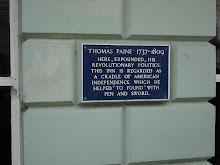

I am reminded over on Philip Wilkinson's excellent blog 'English Buildings' of the plotland developments which took place in various parts of England. As this blog is named for one such, it's worth a mention. New Anzac-on-Sea was the prizewinning name resulting from a competition, set by Charles Neville, to christen his baby town. Later of course it became Peacehaven, a place reviled by planners throughout the land. Some plotlands grew up as a result of like-minded religious or political groups wishing to establish very basic self-sufficient communities. The homes they built were often rudimentary and made from that most adaptable of materials, corrugated iron - often redundant railway carriages were purchased and, devoid of their wheels, set Rowland Emmett-like upon railway sleepers - to my mind a most attractive and commodious dwelling. A wonderful hangover of this 'adaptation' still sits, not in a plotland at all, but in the chocolate box village of Slindon West Sussex, where one such carriage is wonderfully preserved and thatched to blend into its surroundings. Peacehaven however was born of no such social or altruistic intentions, rather it was the brainchild of the entrepreneur Charles Neville a land speculator whose sometimes questionable interests had taken him to Canada, Australia and beyond. During the Great War he purchased his first tract of land which comprised some of the coastal strip running from Rottingdean in the West to just shy of Newhaven in the East. Ever the grand publicist Neville used press advertising and direct marketing to great effect and one of his first stunts was to run a competition to name what he would later describe as his 'Garden City by the Sea' and from some 80,000 entries, the name 'New Anzac-on-Sea' was chosen, it is said as a tribute to the Australian and New Zealand Army Corps who served so valiantly in France. The prize for naming was £100 and the runners-up were to receive building plots to the value of £50 each...the straws were in the wind however and instead of there being just a few second prizes, there were 12,500! and these were then asked to pay various 'registration fees' . Once these were gathered in the number of takers dropped considerably and eventually Neville made a considerable profit on his 'Free' plots. Subsequently with the backing of The Daily Express 150 plotholders succeeded in suing him for fraud and he was forced to pay back his ill gotten gains. Ever the fighter, Neville counter-sued the Express for libel and won £300 damages. This then was the inauspicious birth of 'The Garden City by the Sea' - I will return to its history for as well as being an object lesson in how not to plan a town, some of its early social manifestations were luadable in their intent. As I think John Seymour said, what was so awful that men returning from the horrors and carnage of The Great War should spendtheir pathetic little gratuities in an attempt to find calm for their souls and troubled minds in such a perfect South facing strip of Sussex downland.
By the way, the picture of the thatched railway carriage is by Simon Carey and used under The Creative Commons licence.
